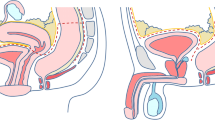Abstract
Background and aims
The surgical treatment of low rectal cancer commonly includes low pelvic anastomoses with coloanal or ultralow colorectal anastomoses. Anastomotic leak rates in low pelvic anastomoses range from 4 to 26%. Many surgeons opt to routinely create a diverting ostomy to reduce the extent of morbidity should an anastomotic leak occur. The intent of our study was to determine if our policy of selected diversion is safe.
Materials and methods
A retrospective chart review of 66 rectal cancer patients who underwent proctectomy and low pelvic anastomoses—less than 6 cm from anal verge, with or without a diverting ostomy—was undertaken. Temporary diverting stomas were utilized at the discretion of the attending surgeon primarily based on subjective criteria. The main outcome was postoperative complications.
Results/findings
Forty-nine patients (78% preoperatively irradiated) were treated with a one-stage operation, whereas 17 (53% preoperatively irradiated) underwent reconstruction with proximal diversion. The mean anastomotic height for patients with a single stage procedure was 3.8 cm above the anal verge versus 2.6 for patients with a two-stage procedure (p = 0.076). Complication rates were lower in patients who did not undergo diversion (29% vs 47%, p = 16). With regard to anastomotic-associated complications for single stage versus two stage, complication rates were 8% versus 18%, respectively (p = 0.27).
Interpretation/conclusion
Low pelvic anastomoses in rectal cancer patients can be safely performed as a single-stage procedure, reserving the use of diversion for select cases.
Similar content being viewed by others
References
American Cancer Society (2005) Cancer society facts and figures. American Cancer Society, New York
Wu JS, Fazio VW (2004) Management of rectal cancer. J Gastrointest Surg 8(2):139–149
Mitry E, Barthod F, Penna C, Nordlinger B (2002) Surgery for colon and rectal cancer. Best Pract Res Clin Gastroenterol 16(2):253–265
Bokey EL, Chapuis PH, Fung C, Hughes WJ, Koorey SG, Brewer D, Newland RC (1995) Postoperative morbidity and mortality following resection of the colon and rectum for cancer. Dis Colon Rectum 38(5):480–486
Cameron JL (2001) Current Surgical Therapy, 7th edn. Mosby, St. Louis
Kanellos I, Vasiliadis K, Angelopoulos S, Tsachalis T, PRamateftakis MG, Mantzoros I, Betsis D (2004) Anastomotic leakage following anterior resection for rectal cancer. Tech Coloproctol 8(Suppl 1):s79–s81
Karanjia ND, Corder AP, Holdsworth PJ, Heald RJ (1991) Risk of peritonitis and fatal septicaemia and the need to defunction the low anastomosis. Br J Surg 78(2):196–198
Marusch F, Koch A, Schmidt U, Geibetaler S, Dralle H, Saeger HD, Wolff S, Nestler G, Pross M, Gastinger I, Lippert H (2002) Value of a protective stoma in low anterior resections for rectal cancer. Dis Colon Rectum 45(9):1164–1171
Hallbook O, Sjodahl R (1996) Anastomotic leakage and functional outcome after anterior resection of the rectum. Br J Surg 83(1):60–62
Law WI, Chu KW, Ho JW, Chan CW (2000) Risk factors for anastomotic leakage after low anterior resection with total mesorectal excision. Am J Surg 179(2):92–96
Van de Pavoordt HD, Fazio VW, Jagelman DG, Lavery IC, Weakley FL (1987) The outcome of loop ileostomy closure in 293 cases. Int J Colorectal Dis 2(4):214–217
Leester B, Asztalos I, Polnyib C (2002) Septic complications after low anterior rectal resection—is diverting stoma still justified? Acta Chir Iugosl 49(2):67–71
American Joint Committee on Cancer (2002) Cancer staging manual AJCC. Lippincott Raven Publishers, Philadelphia
Hallbook O, Pahlman L, Krog M, Wexner SD, Sjodahl (1996) Randomized comparison of straight and colonic J pouch anastomosis after low anterior resection. Ann Surg 224(1):58–65
Redmond HP, Austin OM, Clery AP, Deasy JM (1993) Safety of double-stapled anastomosis in low anterior resection. Br J Surg 80(7):924–927
Matthiessen P, Hallbook O, Andersson M, RUtegard J, Sjodahl R (2004) Risk factors for anastomotic leakage after anterior resection of the rectum. Colorectal Dis 6(6):462–469
Gatt M, MacFie J, Mahon C, Mainprize K (2005) Risk factors for anastomotic failure after total mesorectal excision of rectal cancer. Br J Surg 92:211–216
Chang SC, Lin JK, Yang SH, Jiang JK, Chen WC, Lin TC (2003) Long-term outcome of anastomosis leakage after curative resection for mid and low rectal cancer. Hepatogastroenterology 50(54):1898–1902
Bell SW, Walker KG, Rickard MJ, Sinclair G, Dent OF, Chapuis PH, Bokey EL (2003) Anastomotic leakage after curative anterior resection results in a higher prevalence of local recurrence. Br J Surg 90(10):1261–1266
Machado M, Hallbook O, Goldman S, Nystrom PO, Jarhult J, Sjodahl R (2002) Defunctioning stoma in low anterior resection with colonic pouch for rectal cancer: a comparison between two hospitals with a different policy. Dis Colon Rectum 45(7):940–945
Wiggers T, van de Velde CJ (2002) The circumferential margin in rectal cancer. Recommendations based on the Dutch total mesorectal excision study. Eur J Cancer 38:973–976
Turner II, Russell GB, Blackstock AW, Levine EA (2004) Impact of neoadjuvant therapy on postoperative complications in patients undergoing resection for rectal adenocarcinoma. Am Surg 70(12):1045–1049
Rullier E, Laurent C, Garrelon JL, Michel P, Saric J, Parneix M (1998) Risk factors for anastomotic leakage after resection of rectal cancer. Br J Surg 85(3):355–358
Vignali A, Fazio VW, Lavery IC, Milson JW, Church JM, Hull TL, Strong SA, Oakley JR (1997) Factors associated with the occurrence of leaks in stapled rectal anastomoses: a review of 1,014 patients. J Am Coll Surg 185(2):105–113
Pakkastie TE, Luukkonen PE, Jarvinen HJ (1994) Anastomotic leakage after anterior resection of the rectum. Eur J Surg 160(5):293–297
Author information
Authors and Affiliations
Corresponding author
Rights and permissions
About this article
Cite this article
Kong, A.P., Kim, J., Holt, A. et al. Selective treatment of rectal cancer with single-stage coloanal or ultralow colorectal anastomosis does not adversely affect morbidity and mortality. Int J Colorectal Dis 22, 897–901 (2007). https://doi.org/10.1007/s00384-007-0274-2
Accepted:
Published:
Issue Date:
DOI: https://doi.org/10.1007/s00384-007-0274-2




